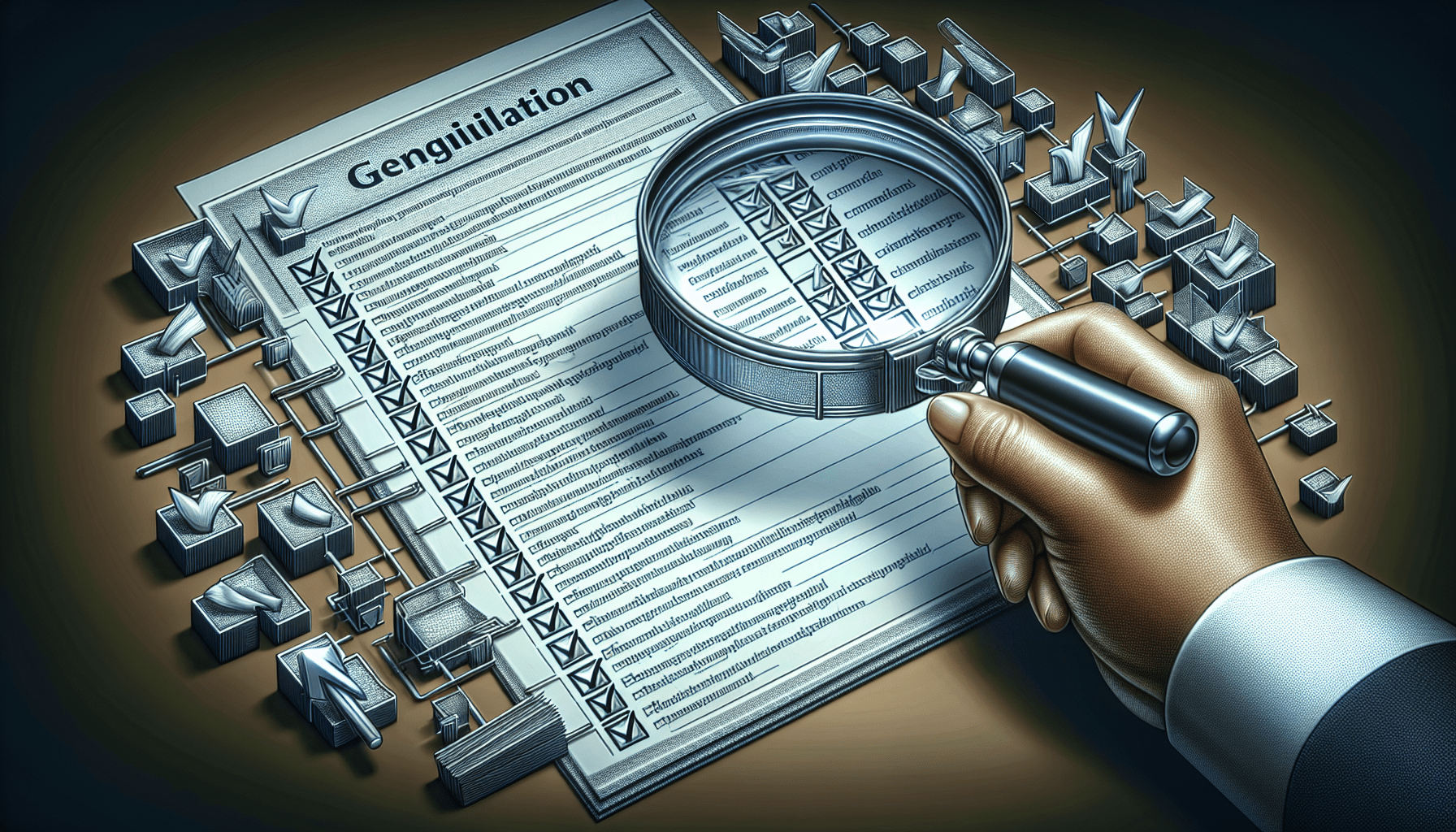In today’s ever-evolving business landscape, regulatory compliance has become a top priority for organizations. Compliance audits ensure that companies are adhering to legal and industry-specific regulations, protecting their reputation and avoiding hefty fines. However, preparing for a compliance audit can be a daunting task. This article will guide you through the essential steps and best practices to effectively prepare for a compliance audit, ensuring a smooth and successful process.
Understanding Compliance Audits
What is a compliance audit?
A compliance audit is a systematic and objective examination of an organization’s policies, procedures, and practices to ensure they are in line with applicable laws, regulations, and industry standards. The goal of a compliance audit is to assess whether an organization is adhering to the required guidelines and identify any areas of non-compliance.
Why are compliance audits important?
Compliance audits play a crucial role in helping organizations maintain legal and ethical standards. They provide assurance to stakeholders, such as regulators, investors, customers, and employees, that the organization operates in a manner that is compliant with laws and regulations. Compliance audits also help identify potential risks, improve internal controls, and prevent or detect violations that could lead to legal and financial consequences.
What are the common areas that compliance audits cover?
Compliance audits typically cover a wide range of areas specific to the industry or sector in which the organization operates. Some common areas that compliance audits may cover include:
-
Regulatory compliance: ensuring adherence to laws and regulations governing the industry, such as data privacy, consumer protection, and environmental regulations.
-
Financial compliance: ensuring accurate financial reporting, adherence to accounting standards, and compliance with tax laws.
-
Human resources compliance: ensuring compliance with employment laws, safety regulations, and diversity and inclusion policies.
-
Information security compliance: ensuring protection of sensitive data, adherence to cybersecurity standards, and compliance with data privacy laws.
-
Quality and safety compliance: ensuring adherence to quality control standards, product safety regulations, and industry-specific certifications.
-
Ethical and corporate governance compliance: ensuring compliance with codes of conduct, anti-corruption policies, and corporate social responsibility initiatives.
Having a comprehensive understanding of these areas is essential for organizations to prepare for compliance audits effectively.
Preparing Documentation
Know the required documents
To prepare for a compliance audit, it is crucial to have a clear understanding of the specific documents that may be required for the audit. These documents can include policies and procedures, contracts and agreements, financial statements, employee records, training records, incident reports, and various other documentation relevant to the areas covered by the audit. Familiarize yourself with the regulations and guidelines applicable to your industry to ensure you have all the necessary documents in place.
Gather and organize the documents
Once you have identified the required documents, it is essential to gather and organize them in a systematic manner. This involves creating a central repository or file system where all the relevant documents can be securely stored and easily accessed. Implementing a document management system or utilizing cloud storage solutions can streamline the process and ensure that documents are organized, readily available, and protected from loss or unauthorized access.
Review and update existing documents
Before the compliance audit, it is essential to review the existing documents to ensure they are up to date, accurate, and reflect the current state of your organization’s policies and practices. Identify any gaps or discrepancies between the documented procedures and the actual operations and make necessary updates. Regularly reviewing and updating your documentation helps ensure that your organization remains compliant and avoids any potential issues during the audit.

Conducting a Gap Analysis
Identify gaps in compliance
A gap analysis is a critical step in preparing for a compliance audit as it helps identify areas where the organization falls short of compliance requirements. It involves comparing the current practices and controls with the applicable laws, regulations, and industry standards to identify any gaps or deficiencies. The gaps can range from minor procedural issues to more significant non-compliance risks. By identifying these gaps, organizations can prioritize and address the areas that require immediate attention before the audit.
Assess risks and potential consequences
Once the gaps in compliance have been identified, the next step is to assess the associated risks and potential consequences. This involves evaluating the severity and likelihood of each identified gap and understanding the potential impact on the organization in terms of regulatory penalties, legal liabilities, reputational damage, or financial losses. This risk assessment helps organizations prioritize their efforts and allocate resources efficiently to mitigate the most significant compliance risks first.
Develop an action plan to address gaps
After conducting the gap analysis and risk assessment, organizations should develop a detailed action plan to address the identified gaps in compliance. The action plan should outline specific steps, responsible parties, and timelines for implementing corrective measures. It should also include mechanisms for monitoring and tracking progress to ensure that the necessary changes are effectively implemented and sustained over time. Regularly reviewing and updating the action plan is crucial to ensure ongoing compliance and continuous improvement.
Establishing Internal Controls
Implementing policies and procedures
Establishing robust internal controls is vital to ensure compliance with laws, regulations, and industry standards. Internal controls are the policies, procedures, and systems implemented by an organization to safeguard assets, mitigate risks, and ensure accurate and reliable financial reporting. These controls should be designed to prevent and detect non-compliance, provide a clear framework for decision-making, and promote accountability throughout the organization. Implementing clear and comprehensive policies and procedures is essential to guide employees’ actions and ensure consistent compliance.
Assigning responsibility for compliance
Effective compliance requires a clear allocation of responsibilities and accountabilities within the organization. Clearly define roles and responsibilities related to compliance and ensure that individuals with the necessary expertise and authority are assigned to oversee and monitor compliance activities. This includes designating compliance officers or compliance teams responsible for implementing, monitoring, and reporting on compliance matters. Regular communication and collaboration with these individuals or teams is crucial to ensure a coordinated and integrated approach to compliance.
Monitoring and reviewing internal controls
Establishing internal controls is not a one-time effort; it requires ongoing monitoring and review to ensure their effectiveness and relevance. Regularly monitor and assess the adequacy of internal controls to identify any weaknesses, gaps, or evolving risks. This can be achieved through periodic internal audits, self-assessments, or external reviews conducted by independent auditors. The results of these monitoring activities should be used to update and improve internal controls continuously and address any identified deficiencies promptly.

Training and Education
Educate staff on compliance requirements
Ensuring that all employees are aware of and understand their compliance obligations is essential to maintain a culture of compliance within the organization. Provide comprehensive training to employees on relevant laws, regulations, and internal policies that apply to their roles and responsibilities. This training should not be limited to initial onboarding but should be an ongoing process to address new regulations or changes to existing ones. Engage employees through interactive training sessions, workshops, online modules, or other learning opportunities that promote understanding and compliance.
Provide ongoing training opportunities
To keep pace with evolving regulations and industry standards, organizations should provide ongoing training opportunities to employees. This includes staying updated on changes in compliance requirements, emerging risks, and best practices. Offer specialized training programs, continuing education, or certifications related to specific compliance areas to employees whose roles require in-depth knowledge of complex regulations. By investing in continuous education, organizations can ensure that employees possess the necessary skills and knowledge to effectively meet compliance obligations.
Promote a culture of compliance
Beyond training, organizations should foster a culture of compliance throughout the organization. This involves creating an environment where ethical behavior, integrity, and compliance with laws and regulations are valued and rewarded. Establish clear expectations for ethical conduct, encourage open communication, and provide channels for employees to report concerns or seek guidance without fear of retaliation. Recognize and reinforce compliance efforts and successes, and address any compliance violations promptly and fairly. By embedding compliance into the organizational culture, organizations can strengthen their overall compliance program and reduce the likelihood of non-compliance issues.
Assessing Third-Party Relationships
Identify and evaluate third-party vendors
Many organizations rely on third-party vendors, suppliers, or contractors to support their operations. However, these relationships can introduce compliance risks if not managed effectively. Before engaging third parties, conduct thorough due diligence to assess their compliance history, financial stability, reputation, and adherence to applicable laws and regulations. This can involve reviewing their compliance policies, conducting background checks, and seeking references from other clients. Regularly review and update the list of approved vendors, and establish criteria for ongoing monitoring and evaluation of their compliance performance.
Review contracts and agreements
When entering into contractual relationships with third parties, it is essential to incorporate compliance requirements into the contracts and agreements. Define clear expectations regarding compliance obligations, data protection, confidentiality, and any specific regulatory requirements that apply to the services provided. Include provisions for monitoring, reporting, and auditing the third party’s compliance with the contract terms. Ensure that contractual agreements include appropriate remedies or penalties for non-compliance to protect the organization’s interests and mitigate potential risks.
Establish monitoring and oversight mechanisms
Once third-party relationships are established, ongoing monitoring and oversight are crucial to ensure continued compliance. Implement mechanisms to regularly assess the third party’s compliance performance, such as periodic audits, performance reviews, or access to relevant documentation. Maintain open lines of communication with the third party, providing guidance and support as needed to address any compliance issues promptly. Consider establishing a formal escalation process to address significant compliance concerns or breaches that may require immediate action or termination of the relationship.
Conducting Mock Audits
Simulate a compliance audit process
Conducting mock audits can help organizations prepare for the actual compliance audit by simulating the audit process and identifying potential areas of non-compliance. This involves selecting a representative sample of documents, processes, and controls and subjecting them to a structured review using the same criteria and methodologies employed by external auditors. Mock audits can help identify weaknesses or gaps in the existing compliance program, evaluate the effectiveness of internal controls, and ensure readiness for the actual audit.
Evaluate effectiveness of controls
During the mock audit, evaluate the effectiveness of the organization’s internal controls to identify any deficiencies or potential areas of weakness. Assess whether the controls adequately mitigate compliance risks, provide accurate and timely information, and are consistently applied across the organization. Identify any gaps or areas that require improvement and develop an action plan to address these issues before the actual audit. Regularly conducting mock audits can help organizations refine their compliance program, strengthen controls, and enhance overall compliance readiness.
Address any identified deficiencies
The purpose of conducting mock audits is not just to identify deficiencies, but also to take prompt action to address them. After completing the mock audit, review the findings and prioritize the identified deficiencies based on their potential impact on compliance. Develop a corrective action plan to address each deficiency, assigning responsible parties and timelines for implementation. Remedy any weaknesses or gaps in internal controls, update policies and procedures, and ensure that the necessary corrective actions are taken to improve compliance readiness.
Engaging External Auditors
Research and select a reputable auditor
When engaging external auditors for a compliance audit, it is essential to conduct thorough research and select a reputable auditor with relevant experience and expertise in your industry. Seek recommendations from trusted sources, review the auditor’s qualifications, track record, and professional certifications. Request and review their sample audit reports to assess the quality and rigor of their work. Conduct interviews or meetings with potential auditors to determine their approach, methodologies, and the level of collaboration they offer throughout the audit process.
Provide necessary documentation and access
To facilitate an effective and efficient compliance audit, provide the external auditors with all the necessary documentation and access to relevant systems, records, and personnel. Ensure that the requested documents are readily available and organized in a manner that supports easy retrieval and review. Assign a point of contact within your organization to liaise with the auditors, answer any questions, and provide any additional information that may be required. Open and transparent communication between your organization and the auditors is crucial for a successful audit.
Collaborate during the audit process
Throughout the audit process, maintain open lines of communication and collaborate with the external auditors. Be responsive to their inquiries, provide accurate and complete information, and address any concerns or issues raised during the audit promptly. Consider offering auditors the opportunity to observe internal control procedures, interviews with relevant personnel, or other activities that will help them gain a comprehensive understanding of your organization’s compliance program. Collaborating with external auditors can foster a constructive working relationship, enhance audit quality, and facilitate the identification of compliance gaps or areas for improvement.
Responding to Findings and Remediation
Review audit findings and recommendations
After the completion of the compliance audit, it is crucial to review the audit findings and recommendations in detail. Gain a thorough understanding of the identified non-compliance issues, gaps, weaknesses, or areas for improvement. Evaluate the potential impact of these findings on your organization’s compliance and assess the severity and urgency of each recommendation. Prioritize the identified issues based on their significance, potential risks, and the effort required for remediation.
Develop a plan for remediation
Once the audit findings have been reviewed, develop a comprehensive plan for remediation. This plan should outline the specific actions, responsible parties, timelines, and resources required to address and resolve each identified issue. Ensure that the plan is realistic, achievable, and aligned with the organization’s priorities and capabilities. Assign accountability for each remediation action and establish mechanisms for monitoring and tracking progress to ensure timely and effective resolution of the identified issues.
Implement corrective actions
The success of the compliance audit process ultimately relies on the organization’s ability to implement the necessary corrective actions. Execute the developed remediation plan by addressing each identified issue systematically. This may involve updating policies and procedures, enhancing internal controls, providing additional training or resources to employees, or making other changes to improve compliance. Regularly monitor the progress, evaluate the effectiveness of the implemented actions, and make adjustments as needed to ensure sustained compliance and continuous improvement.
Continuous Compliance Monitoring
Establish ongoing monitoring procedures
Compliance is not a one-time achievement but an ongoing process that requires continuous monitoring and evaluation. Establish procedures to monitor compliance on an ongoing basis, such as periodic internal audits, self-assessments, or regular reviews of key control indicators. Continuously monitor changes in laws, regulations, and industry standards relevant to your organization to ensure timely updates to your compliance program. Implement procedures for tracking and documenting any changes to compliance requirements and assess their impact on your organization.
Conduct periodic self-assessments
In addition to external audits, conduct periodic self-assessments to evaluate the effectiveness of your organization’s compliance program. Self-assessments involve reviewing internal controls, policies, and procedures, and conducting a gap analysis to identify any emerging compliance risks or areas requiring improvement. Use the findings from self-assessments to improve internal controls, update policies and procedures, and enhance employees’ understanding of compliance requirements. Self-assessments provide an opportunity to address any identified gaps before they become significant compliance issues.
Stay updated on regulatory changes
To maintain compliance, it is crucial to stay informed about regulatory changes that may affect your organization. Establish processes to monitor and track changes in laws, regulations, and industry standards relevant to your industry. Regularly review official publications, regulatory websites, industry newsletters, and other reputable sources to stay informed about any new or amended requirements. Consider subscribing to regulatory update services or engaging legal or compliance experts to ensure you remain up to date with the regulatory landscape. Having a proactive approach to monitoring regulatory changes will help you anticipate and adapt to compliance requirements efficiently.
In conclusion, preparing for a compliance audit requires a comprehensive and systematic approach. By understanding the purpose and importance of compliance audits, preparing the necessary documentation, conducting a gap analysis, establishing internal controls, providing training and education, assessing third-party relationships, conducting mock audits, engaging external auditors, responding to findings and remediation, and establishing continuous compliance monitoring procedures, organizations can ensure compliance with laws, regulations, and industry standards. By staying proactive and diligent in maintaining compliance, organizations can enhance their reputation, mitigate risks, and achieve sustainable success in today’s ever-changing regulatory environment.



